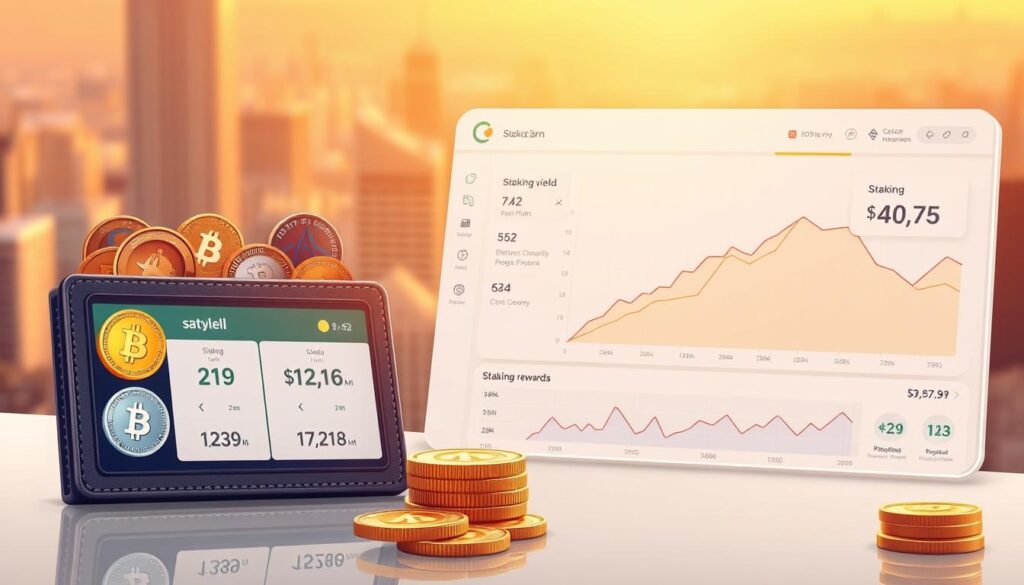Cryptocurrency has grown into a major asset class, with combined market value near $3 trillion. Many holders now use staking, lending, and liquidity rewards to generate regular returns without day trading. These methods can offer steady rewards and potential compounding when used carefully.
This guide focuses on practical, risk-aware steps for U.S. investors. You will learn how different approaches work, how to set measurable goals, and how to weigh volatility, platform risk, and taxes. Rigorous research and platform vetting matter: fraud losses topped $5.6 billion in 2023, so security comes first.
Expect both attractive opportunities and sharp drawdowns. We cover mechanics, centralized versus decentralized access, wallet setup, staking strategies, lending and liquidity, tax implications, and optimization techniques. The aim is to help you turn rewards into lasting gains while tracking net results after fees and taxes.
Key Takeaways
- Staking, lending, and liquidity options can create steady rewards without active trading.
- Balance yield potential with platform safety, regulatory change, and market volatility.
- Track net returns after fees and taxes to ensure money truly compounds.
- Use diversification across assets and strategies to smooth earnings variability.
- Prioritize on-chain data and reputable sources when researching opportunities.
Why crypto earn programs matter now for passive income
Digital asset markets now offer established pathways to steady returns beyond trading. The market has grown toward a multitrillion-dollar scale and that growth expanded ways to generate rewards, from staking large networks to sharing fees on decentralized exchanges.
Yields in this space move fast. Rates reflect network demand, token incentives, and market cycles. That means returns can beat many bank options but they also shift with volatility.
For U.S. investors, choice matters. Centralized exchanges like Coinbase provide user-friendly access while DeFi protocols offer more nuanced rewards and risk profiles.
- Start with blue‑chip networks and reputable platforms.
- Compare lockups, opportunity cost, and withdrawal needs.
- Benchmark expected returns versus safer alternatives and size positions accordingly.
| Method | Typical Return Range | Liquidity | Risk Notes |
|---|---|---|---|
| Staking (major networks) | 2–8% APY | Low to medium | Protocol slashing, lockups |
| DeFi yield (DEX/LP) | Variable, 5–20%+ | Medium | Impermanent loss, smart contract risk |
| Centralized savings | 1–6% APY | High | Counterparty and regulatory risk |
How crypto earn programs passive income actually works
Behind every yield is a mechanism: staking secures networks, lending supplies borrowers, and liquidity powers swaps.
Staking locks coins to support proof‑of‑stake blockchains and generates periodic rewards. Running a validator can pay more but needs technical skill and capital. Delegated or liquid staking gives users easier access with lower setup needs.
Lending works in two ways. Centralized platforms match lenders and borrowers off‑chain with custody and KYC. Decentralized markets rely on smart contracts where interest shifts with utilization and demand.
Providing liquidity on DEXs like Uniswap means depositing token pairs to enable swaps. Providers collect trading fees and may receive token incentives, but face impermanent loss if prices diverge.
- APY drivers: token emissions, fee volume, utilization rates, and protocol rules.
- Lockups & withdrawals: fixed staking terms can restrict exits; flexible products often pay lower rates.
- Fee stack: network gas, trading fees, and platform fees reduce gross returns to net realized rewards.

| Method | How it pays | Typical constraints | Main risks |
|---|---|---|---|
| Staking | Periodic token rewards; compoundable | Lockups, slashing for validators | Network bugs, validator misconfig |
| Lending | Interest from borrowers; variable rates | Utilization-driven yields, withdrawal limits | Counterparty default, smart contract flaws |
| Liquidity provision | Share of trading fees + incentives | Impermanent loss, pool composition | Rug pulls, low volume risk |
Choose reputable platforms and size positions to limit exposure. For a practical checklist and tax considerations, see the crypto passive income guide.
Getting started the right way: research, wallet setup, and platform selection
Before funding any account, verify platform credentials and operational history. For U.S. users, confirm that a platform permits American participation and completes independent audits. Document withdrawal terms, lockups, and fee schedules so expectations are clear.

Build a vetted platform shortlist
Use a simple research checklist: does the platform serve U.S. users, has it published third‑party audits, and does it show a clean security record?
- Compare security controls, insurance coverage, and past incident responses.
- Weigh liquidity depth and transparency of terms and fees across platforms and methods.
- Bookmark official domains and verify SSL certificates to avoid phishing.
Wallet choices and safeguards
Choose a wallet stack that fits your investment horizon. Exchange custody suits short‑term trades. Software wallets add flexibility. Hardware wallets protect long‑term assets and staking tokens when supported.
Enable two‑factor authentication, use unique passwords, and store seed phrases offline. Test with small transactions, set up a dedicated email, and register security keys to lower takeover risks.
| Layer | Best use | Key control |
|---|---|---|
| Exchange custody | Convenience, trading | AML/KYC, platform security |
| Software wallets | Daily use, DeFi access | Device hygiene, 2FA |
| Hardware wallets | Long‑term storage, staking | Seed phrase offline, transaction confirmation |
Segregate funds into a spending wallet and a vault wallet to isolate risks. Keep a short runbook that lists routine steps: check balances, confirm domains, and record withdrawal policies. This reduces errors and saves time.
Staking strategies for dependable earnings on proof‑of‑stake networks
Different staking modes trade convenience for yield and liquidity. Delegated staking is easy for most users and needs little tech setup. Running a validator can boost returns but requires hardware, uptime, and minimum capital.
Liquid staking issues tradable tokens that keep liquidity while your assets remain staked. This can improve flexibility but adds smart contract risk.
Delegated vs. validator vs. liquid staking
- Delegated: low effort, low minimums, moderate yields, high accessibility.
- Validator (run your own): higher yields, hardware + ops, larger minimums, slashing risk.
- Liquid staking: tradable derivatives, flexible liquidity, protocol counterparty risk.
Realistic yields (Q1 2025)
Reference points: ETH ≈ 3.2% APY and SOL ≈ 7.1% APY. Rates vary by network and time; always check current on‑chain stats.

Selecting networks and tokens
Prioritize liquidity, validator set health, on‑chain activity, low fees, and a strong security record. Diversify across reputable networks to reduce single‑point failures.
Step-by-step staking flow
- Acquire coins on a vetted U.S.-friendly platform.
- Transfer to a secure wallet or choose a trusted delegation service.
- Pick validators (spread risk) or use liquid staking protocol.
- Stake, monitor on‑chain dashboards, and claim or restake rewards.
| Mode | Effort | Liquidity | Typical risks |
|---|---|---|---|
| Delegated staking | Low | Low to medium | Validator reliability, modest centralization |
| Run validator | High (ops) | Low | Slashing, hardware/uptime failures |
| Liquid staking | Medium | High | Smart contract and protocol counterparty risk |
To maximize net returns, batch claim rewards, choose low‑fee windows, and weigh compounding versus withdrawals. Set thresholds for restaking that match your cash needs and long‑term goals.
Lending, savings, and liquidity rewards: methods to boost earnings
Using lending and liquidity options can transform idle tokens into steady, measurable returns. Below are practical methods U.S. users employ to lift portfolio performance while keeping an eye on risk.

How lending and savings-style products work
Centralized platforms often offer fixed schedules and predictable payouts. Borrowers pay interest and the platform passes a rate to lenders after fees.
Decentralized protocols like Aave and Compound use utilization-based rates that shift with demand. Collateral, liquidation thresholds, and stablecoin markets affect how steady those earnings appear.
DEX liquidity provision and yield farming
Providing token pairs on a DEX (for example, ETH/USDT on Uniswap) earns trading fees and sometimes token incentives. LP tokens can be staked elsewhere to compound returns.
Yield farming stacks boost gross returns but add complexity and smart contract exposure.
Managing liquidity risks and choosing pools
Key risks include impermanent loss when prices diverge, fee volatility, and protocol failures like oracles or incentive changes.
- Assess volume, fee tiers, token correlation, and pool depth.
- Favor correlated pairs, limit leverage, and cap allocations per platform.
- Track APYs weekly and plan exits before incentives decay.
| Method | Typical Return | Main Risk |
|---|---|---|
| Centralized savings | 1–6% APY | Counterparty risk |
| On‑chain lending | Variable, market‑driven | Smart contract risk |
| DEX LP / Yield farming | Variable, fee + incentives | Impermanent loss |
Risk, security, and taxes in the United States: protect funds and net returns
Strong operational controls stop most common threats and keep rewards from evaporating during market stress. Focus on custody, withdrawal hygiene, and clear records so you can act fast when a platform or wallet behaves oddly.
Operational security checklist
- Verify custody arrangements and prefer hardware wallets for long‑term assets.
- Set withdrawal allowlists and require multi‑factor authentication on exchange accounts.
- Limit exposure to unaudited smart contracts; test small deposits before committing funds.
- Run periodic withdrawal tests to confirm you can move funds under pressure.
Common fraud vectors and how to avoid them
Fraud losses topped $5.6 billion in 2023, including rug pulls, fake exchanges, phishing, and impersonators. Attackers often promise guaranteed returns or use cloned domains and social accounts.
- Verify official domains, check audits, and confirm teams via multiple trusted sources.
- Never click unsolicited links; validate emails and social handles before responding.
- Reject offers that guarantee high rewards with no risk; if it sounds too good, it probably is.
U.S. tax basics and record keeping
In the United States, cryptocurrency is treated as property. Staking, lending, and liquidity rewards are generally ordinary income when received at fair market value.
Subsequent sales or swaps can trigger capital gains or losses based on cost basis and holding period. Keep precise records of every transaction and consider crypto tax software or a qualified tax professional.
Counting costs and running periodic risk reviews
Gas fees, platform management fees, and performance fees reduce net APY and should be included in projections before allocating funds.
| Cost type | Impact | Mitigation |
|---|---|---|
| Gas & network fees | Reduces small rewards | Batch transactions, use low‑fee windows |
| Platform fees | Lower net returns | Compare fee schedules, favor transparent platforms |
| Performance & incentive shifts | APY volatility | Rebalance allocations, monitor incentives weekly |
Finally, establish an incident response: revoke approvals, rotate keys, and contact platforms quickly. Regular risk reviews help users adjust strategies as regulatory and security profiles evolve.
Optimization playbook: compounding, rebalancing, and diversified strategies
Smart timing and routine rebalancing help protect gains when yields shift. Set claim thresholds that balance gas fees and the benefit of reinvestment, and use automation tools where available to compound rewards over time.
Trim positions after large run‑ups and add to underweighted assets to keep target risk and return profiles. Diversify across networks, tokens, wallets, and strategies to reduce single‑point failure risk.
Benchmark net APY after fees and taxes, track drawdowns and liquidity, and use dashboards to monitor rewards, claim schedules, and amounts per platform. Review strategy monthly, document changes, and reinvest or de‑risk based on a plan—not emotion—to grow returns steadily.


No comments yet